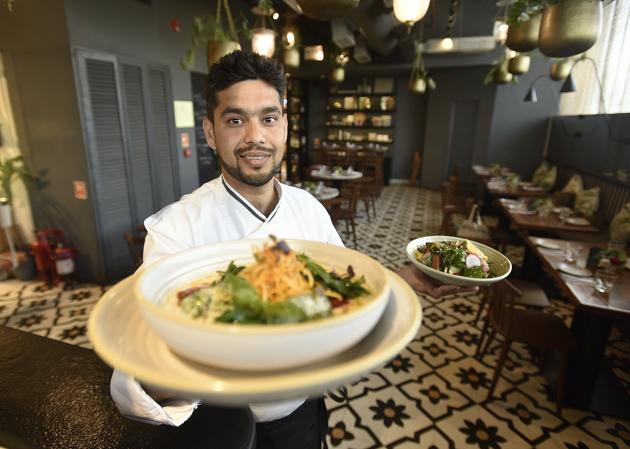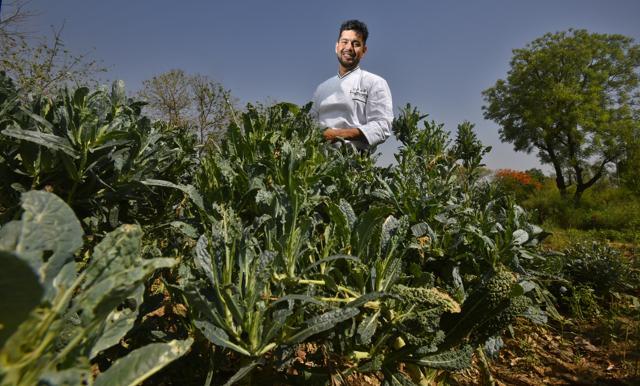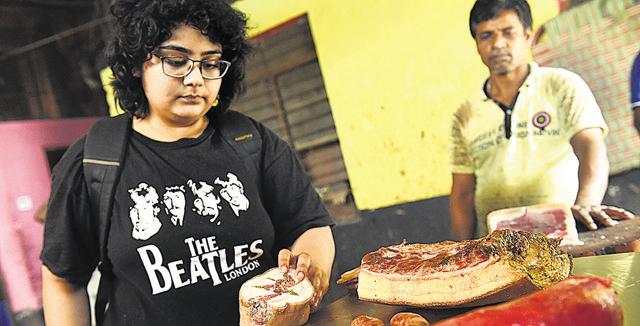From the farm to the chef’s table
The farm-to-table movement seems to have converted city chefs to endorse local produce in a big way. Some of the strongest steps towards sustainability are...
When is a chef more than just a chef? When he can look at a basket of fresh vegetables and know who is responsible. To have a direct link with the supply chain, and even know the farmer by face so as to exchange information on what is growing and when, is no more a USP but a given.

There is indeed, an increasing tribe of chefs in the cities that is literally sourcing from the farm to serve at the table. Eating fresh produce directly from the land near the home goes back to the beginning of time in all cultures.
“The rebirth of the farm-to-fork movement since the mid ’80s in the West has been a conscious move away from processed foods. The emphasis has been on a good working relationship with farmers, clean soil-water environment for the growth of artisanal produce, and fair prices,” says Alice Helme, a culinary expert who works in between Delhi and London and is co-partner at a café chain in Delhi. “It has turned fashionable recently because we have lost the ability to trace where our food comes from.”
Food columnist and author Anoothi Vishal says India became aware of the global farm-to-the-table movement, also called the hyperlocal trend, 15 years ago. But it is only in the last two to five years that younger chefs and food entrepreneurs who may have interned in European restaurants or studied abroad returned to India to realise that the ground had been laid for them to get serious about this. “Everything had started to come together – customer awareness about the carbon footprint of food; social media platforms like Instagram became a place to project being in tune with times not just in what you were wearing but what you were eating or cooking as well; small farmers ready to grow seasonal produce in sustainable ways and hotel and restaurant chefs ready to patronise them.”
It is now part of conventional wisdom that the ‘modern’ way is to source locally. The Jaipur lamb, and the camembert from Mumbai are now as much stacked in the restaurant kitchen pantry as the New Zealand lamb and the Italian parmesan. At least 60-80 per cent of the produce (from veggies to animal and dairy products) of quality city restaurants is being sourced locally. Not one chef will do otherwise. We profile four of those who live this credo .
DELHI

The May sun beats down as chef Lokesh Swami walks through a spinach patch at the Chemon Estate in south Delhi. He is here to chat with the farmers to check if the leaves are young. In a few hours, a fresh batch of spinach and kale will travel 10 km to reach NicoCaara, a restaurant in Chanakyapuri.
The spinach will go into the making of the Baked Ricotta and Ricotta Gnocchi; the kale will sit in a nest of leafy salad next to the salmon. NicoCaara, co-partnered by entrepreneur Ambika Seth (culinary expert Alice Helme is the other partner), is a restaurant specialising in seasonal cuisine that procures its veggies from Seth’s Chemon Estate farm, besides another farm in Nuh, 25 km away, and several other local suppliers, all of whom are on Swami and Seth’s WhatsApp contact-list.
“We plan our menu according to farmers’ alerts. It’s a two-way conversation really,” says the chef as we walk around the Chemon farm. “In August, we will start planning for our winter menu and the farmers will start getting the soil ready to grow the purple radishes, cabbages and carrots. They will be ready by October.”
And if they are not? Swami says the Caara philosophy is not to force the land to give more yield but to sustain a healthy food culture in its restaurants (there are three in Delhi) and the health of its fields.
Swami is a farm boy himself. A follower of Ayurveda, he maintains his own two-acre farm in west Delhi. Fruits and vegetables also “have skin, they breathe, if pumped with chemicals, they harm. This is why we change our menu frequently. Caara’s vegetables are grown completely chemical-free. Whatever the land has to offer in season, we accept”, he says. There is a need to love even “imperfect vegetables”, says Seth who drops in by appointment at the restaurant. “There is also no chance of getting cauliflower as soup or as a side in this season. But what you will get is sweet potato,” she adds.
Food in summer is also being made interesting with lashes of Caara’s home-made sauces such as the Basil pesto, which is used liberally in pastas and salads or on sourdough rye bread.
“The bottled sauces have no preservatives. You need to finish up within a week,” the chef advises a guest who wants to buy a pesto bottle “to keep”.
The kitchen is, in fact, Swami’s lab for trial and error with various ingredients, and to try out different pairings. Recently, he infused hummus with chironji seeds. A summer twist was also given to the traditional Mediterranean mozzarella and tomato salad by using an Indian burratta (cow milk cheese) with a mango salsa. He does not consider this changing the grammar of the dish. “We are all for upping the local content of our food. That’s our everyday practice,” he says.
Recipe of Baked Ricotta gnocchi
Ingredients: Make the ricotta gnocchi with ricotta cheese --100 gm, boiled potato- 30 gm, blanched spinach - 60 gm, bread crumbs - 10 gm, salt, pepper, a pinch of nutmeg powder. Make the tomato coulis/paste with fresh tomatoes - 200 gm, cherry tomatoes - 50 gm, onion - 50 gm, garlic - 10 gm, basil - a handful, olive oil, salt, pepper. Make the cheese fondue with Zarai cheese -40 gm, cream - 50 gm, nutmeg , a pinch, milk - 50 gm, salt, white pepper. .
Method: Mix all the ingredients of gnocchi and make a quenelle shape (an egg-like shape), and put into the refrigerator. For the fresh tomato coulis, heat a pan, add olive oil, chopped garlic and sauté till translucent. Add chopped onion and cook another five to seven minutes. Add fresh and cherry tomatoes. For the cheese fondue, warm milk and cream together and add Zarai cheese and mix well, add seasoning and keep aside to cool. Assemble in a round bowl. Tomato sauce should be the bottom layer, then add the ricotta quenelle and cover with fondue cheese and bake for 10 minutes. Garnish with cherry tomato, crispy potato and fresh basil leaves on top. Serve hot.
Paramita Ghosh
MUMBAI

Thomas Zacharias of The Bombay Canteen (TBC) swears by the Grant Road vegetable market. “The first time I went there myself was in 2014, when I had to cook for the audition for the role of chef at The Bombay Canteen,” he says. “Just walking through the market I had goosebumps, because I was seeing local vegetables that I had never cooked professionally before, like lauki, turai, karela.”
That walk changed everything for Zacharias. “It was almost an epiphany,” he says. “You never see these vegetables on restaurant menus; you generally see a focus on capsicum, potato and paneer. I realised it would be far more exciting to cook with vegetables that were, at that point, unfamiliar to me.”
He cooked the auditioners a 12-course meal that included a dessert made from jackfruit, for which he drew on lessons he learnt from his grandmother, growing up in Kochi. Of course, he got the job (he is now executive chef and partner). And TBC is now known for its hearty, relatable form of fusion Indian cuisine. It’s where you take the foodie cousin from Delhi or the visiting relative from Canada, when you really want to showcase how far Mumbai restaurants have come, and just how much there is to marvel at in the world of Indian cuisines.
Field work and research are integral to the TBC approach. Before getting started at the restaurant, for instance, Zacharias took a two-month trip across Tamil Nadu, Gujarat, Punjab, Maharashtra, West Bengal, Sikkim, Nagaland and Meghalaya. Techniques, ingredients, recipes and stories from that trip would inform the Bombay Canteen menu. So while the recipes are from all over, Zacharias take pride in the fact that most of the ingredients continue to be sourced locally, much of them from the Grant Road market. When you order pumpkin flower pakhala bhaat at the restaurant, for instance, you’re eating a fermented rice dish from Odisha, made with pumpkin from the local market, flowers from a nearby farm, and a local variety of rice called Imrani.
“The trick to a successful market trip,” Zacharias says, “is to ask questions and learn about the vegetables from the people selling them. I use every edible part of the pumpkin tree, for instance. Bharta with the flesh, pickled pumpkin skin, sautéed leaves, pumpkin seeds and fried fritters with the flower.”
TBC also has something called the Indian Ingredient Programme. Once a week, the team picks an Indian ingredient, form teams and begins extensive research into where it’s from, how it’s traditionally cooked, and what it might work well with in new recipes. At the end of the week they pool their findings to decide if, and how, to add the ingredient to the menu.
Among the IIP success stories is the Karuppu Arisi black rice from Tamil Nadu which features in a payasam; and the Ghadiyali yam from Uttarakhand, which pops up on the winter menu as Ghadiyali rawa fry. Often, these ingredients first appear in the now-famous TBC staff lunch, which is what the staff eats, but can be ordered by diners looking to be the first to try new experiments from the TBC kitchen.

Recipe of Bengali Potol Bhaja
Ingredients: ½ kg Baby Padval / Potol, salt to taste
Method: Partially peel off the skin of the vegetable by using the sharp edge of a knife. Using a knife, make slits at angles down into the padval along the side and on opposite sides. Season with salt and keep aside. Deep fry till crispy.
Madhusree Ghosh
KOLKATA

Older than New Market, Fenwick Bazaar was the original Eurasian market of colonial Calcutta. Its famous meat storages, particularly The Old Calcutta Piggery, are gourmet chef Atrei Chatterjee’s go-to shops for local ingredients – from European-style luncheon meat, pancetta, pork collars and hand-rolled salami to Italian and German-style cold cuts. Most of the sausages are hand-sliced and do not have the machine-pressed taste. She also keeps tabs on where the meat is sourced from –– from pigs reared in Tangra, more famously known as Kolkata’s Chinatown.
Atrei runs the eatery Local Gourmet in Sector 2, Salt Lake City, with the help of her partner Rajarshi Chakraborti. She detests machine-processed options, especially when it comes to her meat. “We generally don’t use oil. Most of our food is made using whatever natural animal fat the meat contains,” she says.
“You will find everything here and I like that I get it so fresh not too far from my place of work!” she announces as we walk into the almost century-old piggery; the first item on Atrei’s shopping list is the pancetta, a marbled chunk of Italian bacon, made from salt cured pork belly meat. “You really have to look for it in the city. But the piggery has been selling it for years.”
Some of it will invariably go into the Lecter Platter (yes, cheekily named after the cannibalistic and psychopathic serial killer Hannibal Lecter played by Anthony Hopkins in The Silence of the Lambs). The key ingredients of the platter are smoked bacon, sliced ham, hand-rolled salami and pancetta.
Atrei watches as the piggery worker slices the perfect ham fillet with precision. “The ham can also be purchased whole, if you want to have a good old-fashioned roast. If not, they’ll slice it in front of you,” adds the chef. She calls herself an “ingredient chef”, and seems to be a resourceful gourmet gatherer. Her menu at the restaurant ticks all the right boxes. Home-grown ingredients are used for making kombucha (a fermented drink made from sweetened tea) and kimchi (Korean side dish made from fermented cabbages and radishes), the latter is used to whip up one of the healthiest ramen in the city.
Later in the afternoon, we head back to Local Gourmet, a relaxed, snug space where Atrei plates the Lecter Platter along with sides of semi-smoked barbecue pork and curly potato fries. “The flour used in the fries is actually home-made by some local families,” says the chef.

Recipe of Lecter Platter
Ingredients: Slices of smoked bacon, sliced ham, hand-rolled salami, pancetta.
Method: Heat the pan. Slide in the slices of meat. Fry the slices of meat lightly in the animal fat that oozes out as the meat touches the hot pan. Serve with two dips - BBQ sauce and curried mayonnaise
Ujjainee Roy
BENGALURU

Just past noon, chef Vishvesh Nadkarni strolls down the historic Russell Market at the heart of Bengaluru’s cantonment area to buy some mustard greens. The near-century-old market supplies the best Continental vegetables, locally grown, in the city.
Vishvesh is the sous chef at Avant Garde Hospitality, a catering and F&B consultancy establishment of which Fava, a Mediterranean restaurant, is a part.
Nadkarni shops at the nearby Russell Market because he believes vegetables stay fresh and taste better when they travel less miles to reach the chef’s kitchen table. Having worked previously in the UK, the Maldives and Japan, after he finished a course at Le Cordon Bleu in London, Vishvesh says he was introduced to sustainability practices in his stints abroad.
Nadkarni is planning a Micro Green Salad for us. This dish captures the essence of what Fava and its founder chef Abhijit Saha, stands for. “Local vegetables and environmental sustainability is our motto,” he says. One of the reasons for the salad being central to the idea of Fava is the fact that some of the micro greens are home- grown – they are grown on the terrace where the restaurant is located. “The potted plants you see next to the restaurant are actual ingredients we use in our dishes,” says Vishvesh.
He introduces us to three micro greens, beetroot, mustard greens and sunflower. “This dish is for those who like light flavoured food,” he says. “It fills you up even though it’s so light and healthy,” he adds. The salad itself, dressed simply with extra virgin olive oil and balsamic vinegar with a sprinkling of parmesan and almonds, is truly refreshing especially on a hot summer afternoon. It’s a meal in itself.

Recipe of Micro green salad
Ingredients: Iceberg lettuce, Lollo Rosso lettuce, Arugula lettuce, sunflower micro greens, beetroot micro greens, mustard micro greens, toasted almonds, grated parmesan, halved cherry tomatoes
Method: Assemble all the veggies. Add the Balsamic vinegar dressing and extra virgin olive oil. Add salt as per taste. Sprinkle black pepper powder.
Vikram Gopal






